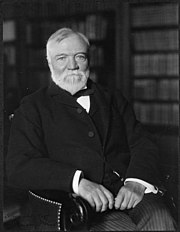Andrew Carnegie Biography and Works.

Andrew Carnegie, (November 25, 1835 – August 11, 1919) was a Scottish American businessman, entrepreneur and philanthropist. He led the enormous expansion of the American steel industry in the late 19th century.
Carnegie was born in Scotland and migrated to the United States. He started working as a factory worker in a bobbin factory. Later, he became a bill logger for the owner of the company and then a messenger boy. Progressing up the ranks of a telegraph company, he built the Pittsburgh’s Carnegie Steel Company, which was later merged with Elbert H Gary’s Federal Steel Company. It further merged with several smaller companies to create the US Steel.
He built the Carnegie Hall and later turned to philanthropy and interests in education. He founded the ‘Carnegie Corporation of New York’, ‘Carnegie Endowment for International Peace’, ‘Carnegie Institution of Washington’, ‘Carnegie Mellon University’ and the ‘Carnegie Museums of Pittsburgh.
Carnegie devoted the remainder of his life to large-scale philanthropy, with special emphasis on local libraries, world peace, education and scientific research.
Trivia
He cemented his name as one of the ‘Captains of Industry’ after he founded the Carnegie Steel Company. By the 1890s, the company was the largest and most profitable industrial enterprise in the world. Carnegie, later, sold it for $480 million to JP Morgan, who then created the US Steel.
- What is meant by Database Management System?
- Discuss the advantages and drawbacks of database.
- What do you mean by database ? Discuss its Characteristics.
- What is Data Mining?
- What are the conditions of communication?
- What do you mean by business communication ?
- organization / Differentiate between classical and modern theory of organization
- What is forecasting






